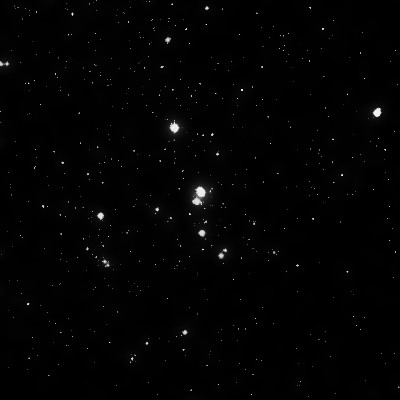
Wilhelm Struve discovered NGC 6871 = h2067 in 1825 or 1826 using the 9.6" refractor at the Dorpat Observatory and included the double star ∑2630 in his main catalogue of double stars. On 5 Aug 1831, JH recorded "A double star ∑2630, in a cluster of 5 bright and many small stars." His position is near the two bright double stars in the center of the cluster and he credited Struve with the discovery.
But by analyzing William Herschel's early "reviews" of bright stars (before his systematic sweeps), which resulted in the discovery of many double stars, Wolfgang Steinicke found (email Oct '16) that Herschel first discovered the cluster on 23 Sep 1783 using his 6.2" reflector.
200/250mm - 8" (6/81): two sets of multiple stars in a very rich field including ß440 = mag 7, 12, 11, 9.5, 11.5, 8 at 7", 11", 11", 28" and 36". Located 13' SW of a mag 5.5 27 Cygni.
300/350mm - 13.1" (8/25/84): dominated by two bright multiple stars: SHJ 314 = 6.8/7.3 at 35" with four additional close companions and SHJ 315 = 7.9/8.8 pair at 20" surrounded by several mag 11 stars. The bright pairs are oriented N-S and separated by about 2'. The cluster itself is in a bright, rich field with no apparent boundaries.
400/500mm - 18" (9/26/11): bright, large, rich cluster but not isolated in the field, so the catalogued diameter of 20' seems somewhat arbitrary. At 175x, roughly 200 stars are visible within the region, though there are really too many to count. The dominant feature are two bright multiple stars near the center: SHJ 314 = 6.8/7.3 at 35" with 4 faint companions and SHJ 315 = 7.9/8.8 at 20" with 8 companions including a trio of mag 11 stars close west, a 15" pair of mag 10.5 stars close east and a tight string of 3 or 4 fainter stars close southeast. NGC 6871 forms a close pair of clusters with Biurakan 1 (centered on a mag 7.3 star), just off the southeast side. The little-known Wolf-Rayet shell surrounding W-R 134/135 lies 45' NE.
Notes by Steve Gottlieb